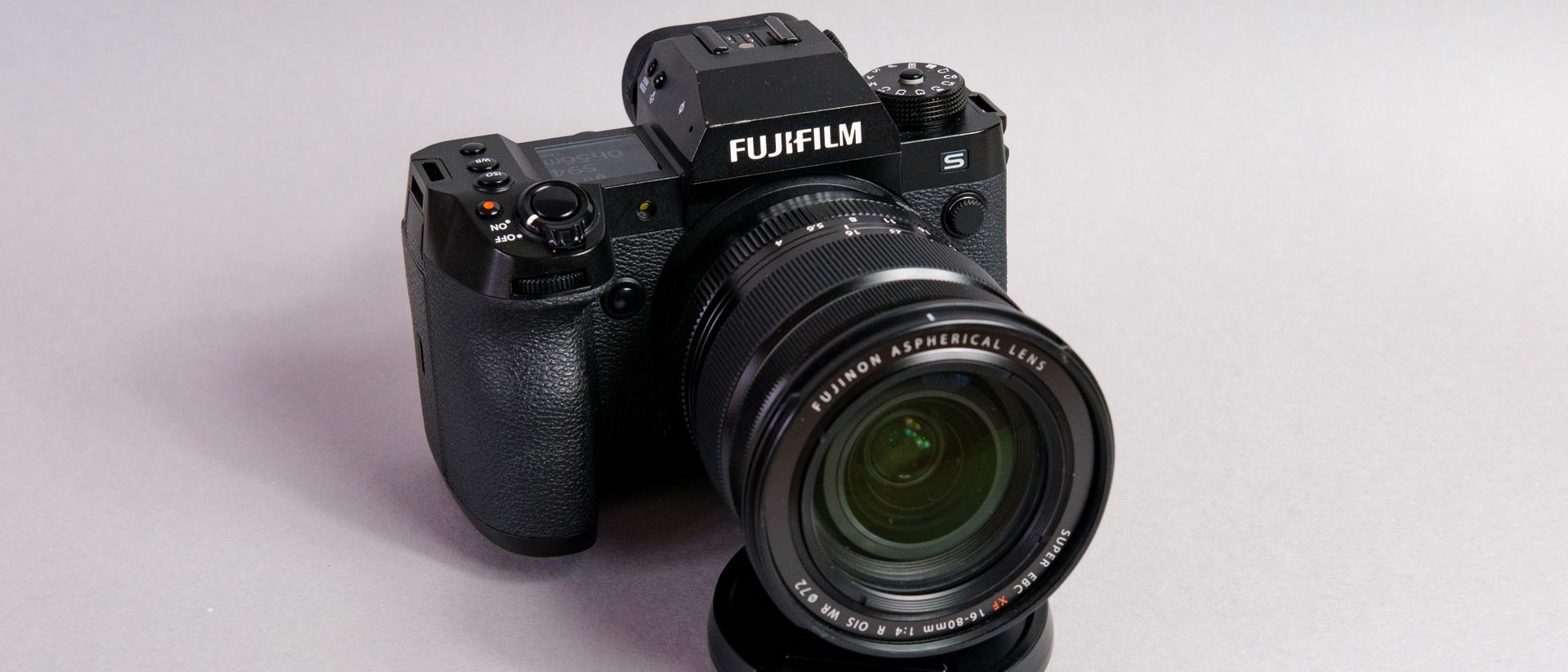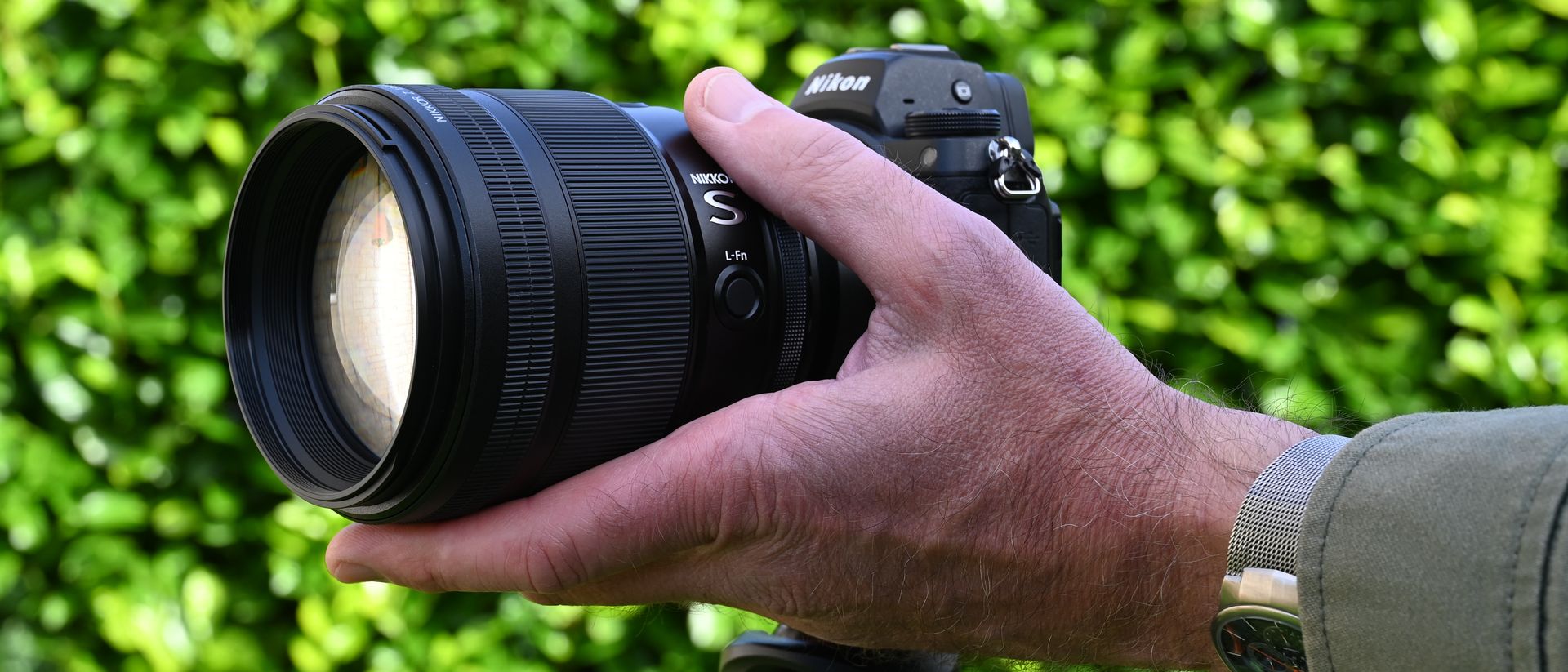Trade in Canon EOS R6
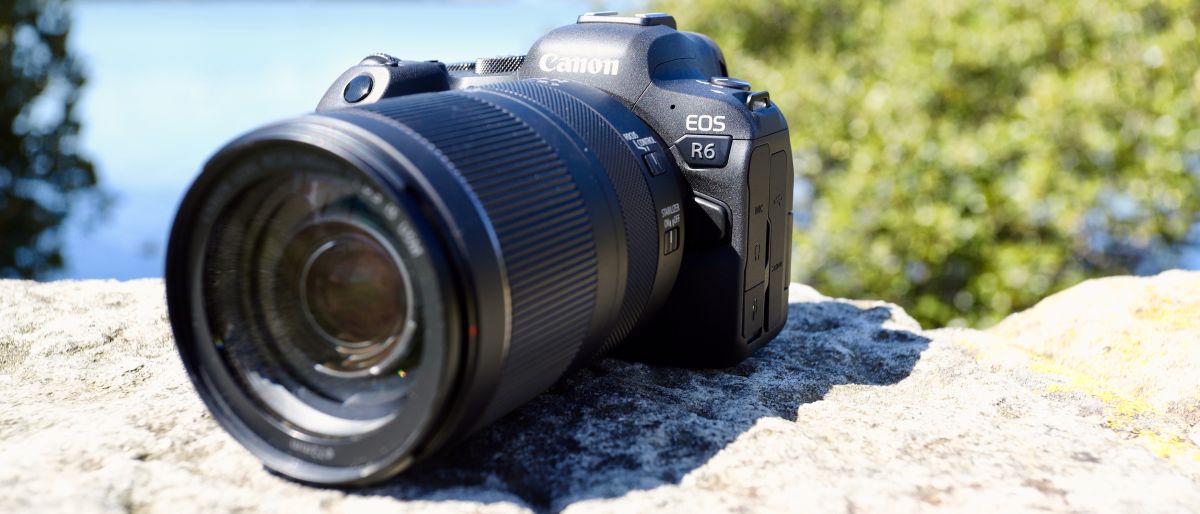
(Image credit: TechRadar)
Two-minute review
Canon’s new EOS R6 may have been overshadowed by its more expensive EOS R5 sibling, but given its impressive feature set, it might become Canon’s most popular camera. It fills the hole left between the EOS R’s pretty impressive skills and the top-end specs of the EOS R5 (which, admittedly, might be too much of a camera for the average user).
To put it simply, the EOS R6 is essentially a more affordable R5, albeit with a significantly lower sensor resolution and more limited (but still excellent) video recording capabilities. And, despite being classed as an enthusiast-level camera, the EOS R6 comes with features that rival Canon’s professional-level – and extremely expensive – models.
Taking a leaf, or two, out of the EOS 1D X Mark III playbook, the EOS R6 inherits the same 20MP sensor resolution as the DSLR but not quite the same sensor. The difference is in the architecture as an upgraded version of Canon’s tried-and-tested Dual Pixel CMOS autofocusing system has been incorporated onto the sensor. This has markedly improved autofocus and tracking performance, with the EOS R6 now able to match, and sometimes outperform, Sony’s Real-Time Tracking Autofocus.
20.1MP is a step down from the 26.2MP pixel count in the EOS 6D Mark II and EOS RP (or the 30MP one in the EOS R), and that’s evident in side-by-side comparisons, although you will have to look really close to be disappointed. However, it’s the dynamic range that’s disappointing – images taken in bright sunlight appear flat, with a lack of detail in highlights and shadows. In comparison, the EOS 6D Mark II performed better in the same situation. That said, image quality is still pretty darn good and shooting with the EOS R6 is an absolute pleasure.
Its ergonomic design makes it comfortable for all-day use, no matter how large or small your mitts are, and you can shoot handheld at shutter speeds as high as 2 seconds and still get remarkably sharp images (provided you have steady hands).
It’s Canon’s first try at in-body image stabilization (IBIS) and, boy, has the company nailed it! It also makes shooting video an absolute pleasure. Yes, there are limitations when shooting 4K footage – and you aren’t going to get the R5’s impressive 8K option here – but Canon has made it very clear that the EOS R6 is first and foremost a stills camera.
Then there’s the marked improvement in speed – while it can’t quite match the 1D X Mark III’s blitzing 16fps burst with the mechanical shutter, the R6 is capable of 12fps bursts. Switch to its electronic shutter and it will match the sports DSLR’s whopping 20fps continuous shooting speed – more than enough for wildlife or sports photography.
Overall, the EOS R6 is a massive upgrade from either the EOS 6D Mark II or even the EOS R and the EOS RP. But all that impressive performance doesn’t come cheap, with higher resolution full-frame mirrorless models now available at a similar price point.
We are Tradelectronics, licensed second-hand electronics dealer located in Sydney CBD, experts in trading used laptops, old cameras & lens, and used mobile phones. Fast, Reliable & We Pay More! Get a free quote on your favourite WhatsApp, Facebook, SMS & Email, instant reply!
| Click icon for WhatsApp Quote | Click icon for facebook Quote |
 |
 |
- We are open from Mon – Sat 12pm – 7pm
- Get your free quote from WhatsApp and Messenger are highly recommended, we can guide you through in finding the accurate specs for your laptops, cameras & lens, mobile phones as well. As such we can provide a more precise quote for you.

(Image credit: TechRadar)
Canon EOS R6 price and availability
- Announced July 2020
- Available right now for $2,499 / £2,499 / AU$4,499
- Limited stock in most markets
Although Canon announced the EOS R6 (and the EOS R5) in early July, the camera didn’t begin shipping until late August. Even then, there were – and still is – very limited stock reaching retailers worldwide due to the current pandemic affecting supply lines. You may be able to book an EOS R6 with authorized Canon retailers right away, and they will be able to let you know when your unit will ship.
The R6 will set you back $2,499 / £2,499 / AU$4,499, which isn’t cheap by any means. That’s an upper-midrange price tag for a camera Canon has classified as enthusiast-level, but costs about as much as other high-end full-frame mirrorless options like the Nikon Z7 or the Sony A7R III, both of which have high-resolution sensors.
That said, given the R6’s feature set, it’s a competitive price point that’s only slightly higher than the $2,299 / £2,349 / AU$3,349 launch price of the EOS R.

(Image credit: TechRadar)
Specs and features
- 20.1MP full-frame CMOS sensor
- IBIS with up to 8 stops of compensation
- Head- and eye-detect AF for animals
There have been so many cameras aimed at video makers that it’s refreshing to know manufacturers haven’t forgotten stills photographers. Canon’s target market for the new EOS R6 is “photographers more focused on stills” who may want to take videos occasionally, with the camera inheriting some top-end features from the EOS 1D X Mark III, starting with its processor.
Canon’s latest Digic X imaging engine works alongside a slightly redesigned 20.1MP full-frame CMOS sensor that, the manufacturer says, is “similar” to the one used in the sports DSLR. The updated sensor incorporates Canon’s second-generation Dual Pixel autofocus architecture (called Dual Pixel CMOS AF II). This has improved phase-difference detection autofocusing in Live View on the R6, and also allows for faster readout speeds during fast continuous shooting and while capturing 4K video at high frame rates. In theory, this should even reduce rolling shutter distortions when using the sensor-based electronic shutter.
20.1MP might seem like a step down for a camera that’s meant to be an all-rounder, but it’s all about the markedly improved speed. The R6 can shoot bursts of 12fps when its mechanical shutter is in use – a remarkable number for a camera that’s aimed squarely at enthusiasts and hobbyists. If that’s not fast enough for you, just switch over to its electronic shutter and the R6 will match the EOS 1D X Mark III’s top speed of 20fps.
Lower pixel count also means bigger pixels, which translates to better light sensitivity and higher signal-to-noise ratio, giving the EOS R6 a native ISO range of 100-102,400 that can be expanded either side to ISO 50 and ISO 204,800 – a massive step up from the EOS R’s native ISO sensitivity of 100 to 40,000. Canon says the decision to use a lower resolution sensor is also to help event photographers manage their workflow – lower pixel count means the file sizes are smaller, thus speeding up transfer rates.
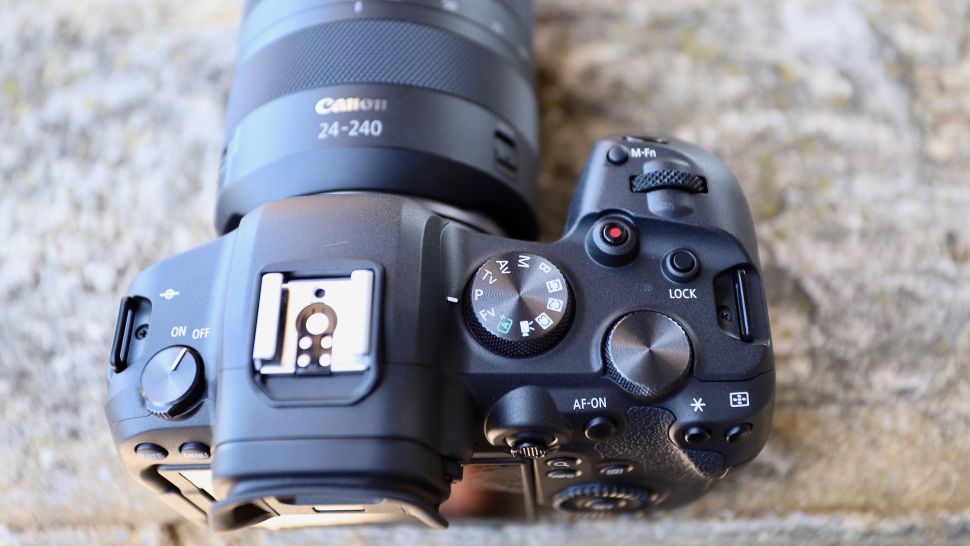
(Image credit: TechRadar)
The headline feature, though, is the addition of in-body image stabilization, something Canon has historically shied away from. The newly designed 5-axis system, Canon says, offers up to 8 stops of compensation when working in tandem with a stabilized lens, although the shutter speed compensation will depend on which lens is being used. For example, with the RF 24-105mm f/4L IS USM lens which has 5-stops of image stabilization, you’ll get 8 stops of coordinated control; however, with the RF 24-240mm f/4-6.3 IS USM lens, which is longer and heavier but has the same 5-stop stability, you’ll get a combined 6.5 stops of stabilization.
This latter is the lens we used during most of our testing and were able to shoot handheld at a shutter speed of 2 seconds at an effective focal length of 24mm – pretty much matching Canon’s claim. And if you use a lens without IS (like the RF 28-70mm f/2), you’ll still get a full 8 stops of stabilization.
The R6’s autofocus system has also been given an impressive boost. There are 6,072 user-selectable AF points covering 100% of the frame – an improvement over the EOS R’s 5,655 AF point system. Canon also claims the R6 (and the R5) have the “world’s fastest AF for a full-frame camera” measured at 0.05 seconds, although the EOS R also lays claim to the same AF acquisition speed. That said, Sony has beaten Canon with the APS-C format Alpha A6400 that has an AF acquisition speed of 0.02 seconds.
Like the 1D X Mark III, the EOS R6 also has HEIF (High Efficiency Image Format) file support. That means images are captured in 10-bit RGB color for wider dynamic range and color gamut. This format also uses a more efficient compression algorithm that saves a lot more information than traditional JPEGs and is a great alternative to anyone who doesn’t shoot in RAW.
In terms of video, the R6 is clearly not competing with the R5. 4K/60p capture is the best you can get here, and in UHD only. There’s no DCI support for a more cinema-like look, but Canon hasn’t designed this camera for videographers. That said, being able to shoot 4K video while utilizing the full width of the sensor is a huge advantage the R6 has over the EOS R and RP.

(Image credit: TechRadar)
Design and handling
- Deep, ergonomic grip
- Joystick multi-controller
- Dual card slots
Physically, the EOS R6 doesn’t offer a huge size advantage over its 6D Mark II DSLR cousin. It’s only marginally lighter and smaller at 680g (compared to the 765g weight of the latter) and dimensions of 138mm x 98mm x 88mm (as opposed to 144mm x 111mm x 75mm for the 6D II). In real-world use, you’ll barely register the difference.
Thanks to its deep grip, the R6 is wonderfully ergonomic for holding and using for long periods of time. And for those worried about the elements, the R6 is weather sealed. In fact, the EOS R6 (and the R5) have the option of keeping the shutter closed when the camera is powered off to minimize dust damage, something you can set up within the menu system.
The body resembles the older EOS R in most ways but there are a few obvious differences – the main one being the return of the joystick multi-controller on the camera’s rear. The touch bar on the rear panel of the EOS R was a sore point of contention amongst many users and it’s good to see that it’s gone. The textured joystick is easy to find without taking your eye off the viewfinder. You can use it to find your choice of AF point easily or to navigate the menu system if you’re not keen on Canon’s touchscreen functionality.

(Image credit: TechRadar)
The other difference on the rear control setup is the return of the Quick Menu (Q) button which was also missing in both the EOS R and the RP. If you’re an existing Canon user, the control layout will, for the most part, be very familiar to you, as will the menu system. For those coming from a completely different system, Canon’s setup has always been very intuitive and easy to use, and just a few minutes spent familiarizing yourself will have you up and running.
On the top, the R6 misses out on the LCD display that’s available on the EOS R and R5 (and also on Canon’s DSLRs) but gets a traditional mode dial that will be familiar to most Canon DSLR users.
The R6 also misses out on the high-resolution viewfinder that’s on the R5, instead getting a 3.69-million dot EVF (matching the EOS R). While a higher resolution EVF would have been grand, there’s absolutely nothing to complain about here – a refresh rate of 119.8fps means you’ll barely notice any blackout.
If you’re not keen on using the EVF, you can always shoot in Live View and frame your image using the 3-inch 1.62-million dot rear touchscreen. This vari-angle display is slightly smaller than the one on the EOS R5, which is 3.2 inches thanks to thinner bezels.
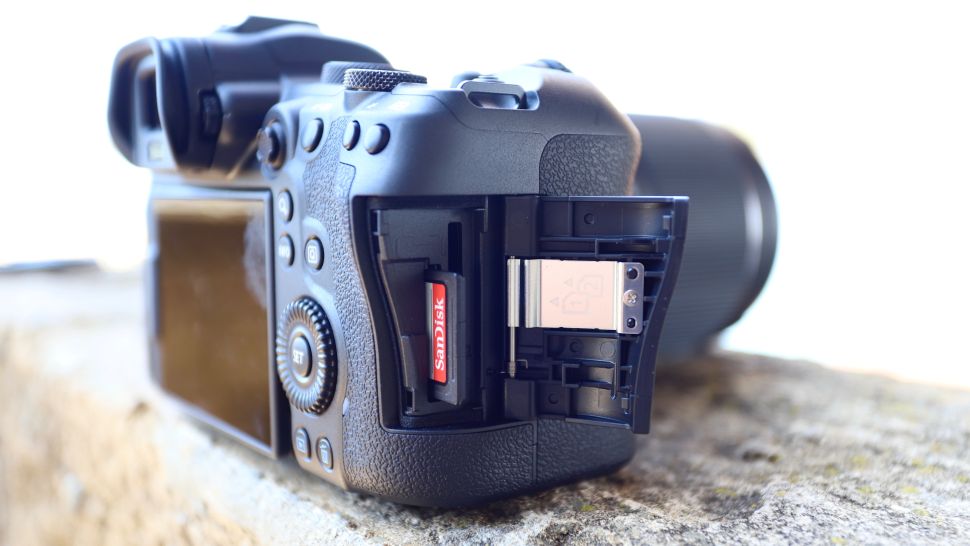
(Image credit: TechRadar)
Another major improvement the R6 brings is dual card slots, both of which support SD UHS-II format. You can record to both simultaneously if you wish or one at a time.
On the opposite side to the memory card slots are all the other ports you’ll need. There’s 3.5mm headphone and mic jacks, a 3.1 Gen 2 speed USB-C port, a micro HDMI port, and an E3 remote shutter terminal. The USB-C port can be used to charge the camera while on the go.
Speaking of charging, both the R6 and the R5 also benefit from a new battery – LPE-6NH – which not only offers better battery life (about 510 shots as per CIPA’s conservative rating) but is also compatible with any Canon body that uses LP-E6N or LP-E6 batteries (like the 6D Mark II, for example).

(Image credit: TechRadar)
Autofocus
- 6,072 AF points
- Dual Pixel CMOS AF II
- 100% horizontal frame coverage
Like the pro-level 1D X Mark III and the more expensive EOS R5, the R6 is remarkably quick and accurate, with autofocus performance that’s arguably best in class. Starting with subject detection, locking onto a face or eye and then tracking the subject – it was all spot-on pretty much every single time we tested it.
Bursts of a seaplane flying show every single frame in sharp focus, as does sequences of shots we took of birds. If the animal or person we were shooting turned away from the camera, the R6 promptly increased the focus box size and locked on to the back of the head. In fact, if the subject turned back to face the camera again, the R6 was able to lock onto an eye without so much as a blink.

(Image credit: TechRadar)
Canon says the animal recognition on the R6 is currently only for cats, dogs and birds, but that doesn’t stop the camera from focusing on anything it thinks is an eye or a head. For subjects as small as bees, the R6 was able to find the insect’s head and stick with it as long as it was on a flower. However, we failed while trying to track the bees as we were too slow to follow the busy bodies, and the out-of-focus images were no fault of the camera but the user’s inability to keep up.
Canon’s new Dual Pixel CMOS AF II system allows focusing to be done on-sensor and gives you a whopping 6,072 AF points to choose from – higher than the R5’s 5.940 user-definable points. These points cover the entire horizontal frame and 90% vertically, which is more than what most intermediate-level cameras offer.
Long story short, there’s no other camera in this class that can do what the R6 does in terms of autofocus, at the speed at which it does, and, arguably, at the price point that it does.
Performance
- Best-in-class full-frame IBIS
- Up to 20fps burst speed
- Improved battery life
With Canon’s latest Digic X imaging engine under the hood, you’d expect the R6 to be a top performer like the 1D X Mark III where the processor debuted. And our tests prove that it is.
The R6 is capable of capturing 5472×3648 pixel images (as compared to the larger 8192×5464 size on the R5) in JPEG or 14-bit RAW files. Compressed RAW is also available, but our file format pick is the 10-bit HEIF. To shoot in this format, you need to enable HDR PQ, which will swap JPEG out for HEIF, and you can convert back to JPEG in-camera as well.
To match the camera’s burst speed, it’s important the R6 have an equally impressive buffer memory. While a lot will depend on the memory card you’re using, the camera handled a burst of about 315 frames during our tests without even thinking about it to a UHS-II SD card.
In fact, you’ll easily be able to save over 1,000 JPEGs or compressed .CR3 RAW files to a UHS-II card without the camera slowing down. If you’re shooting uncompressed RAW, then buffer depth will drop significantly to 240 consecutive files. Either way, that’s way more than what most people will need.

(Image credit: TechRadar)
But it was the image stabilization that we were most keen to test and, boy, did it impress. Paired with the RF 24-240mm f/4-6.3 IS USM lens, which itself has 5-stops of image stability built in, we were supposed to get a total of 6.5 stops of compensation according to Canon’s own claims. That means that at 24mm effective focal length, we should be able to hold the camera for a maximum shutter speed of 2 seconds and, in practice, that worked. The only downside to us capturing pinpoint sharpness was the buffeting wind we were facing. However, 1.6 second shutter speed shot during the same windy evening was perfectly usable.
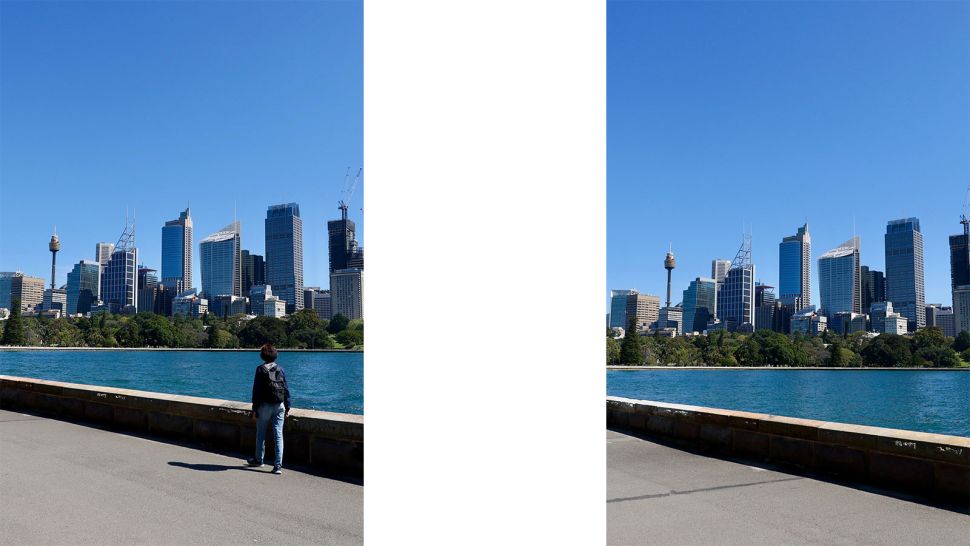
(Image credit: TechRadar)
We also tested how the R6’s electronic shutter would handle itself while panning. Rolling shutter effects are common when shooting with a sensor-based electronic shutter but our tests showed no noticeable distortion while panning slowly, but we did see a significant lean when panning faster.
Image quality
- Excellent color reproduction
- Disappointing dynamic range in JPEGs
- Good ISO performance
Most users would be concerned with the resolving power of the 20MP sensor. As long as you aren’t doing a side-by-side comparison with the R5 – which would be highly unfair – we found the R6 can hold its own.
Images pop with color without appearing oversaturated, as has always been Canon’s trademark. Details are good for the most part but we did find the R6 struggles during bright sunlight.
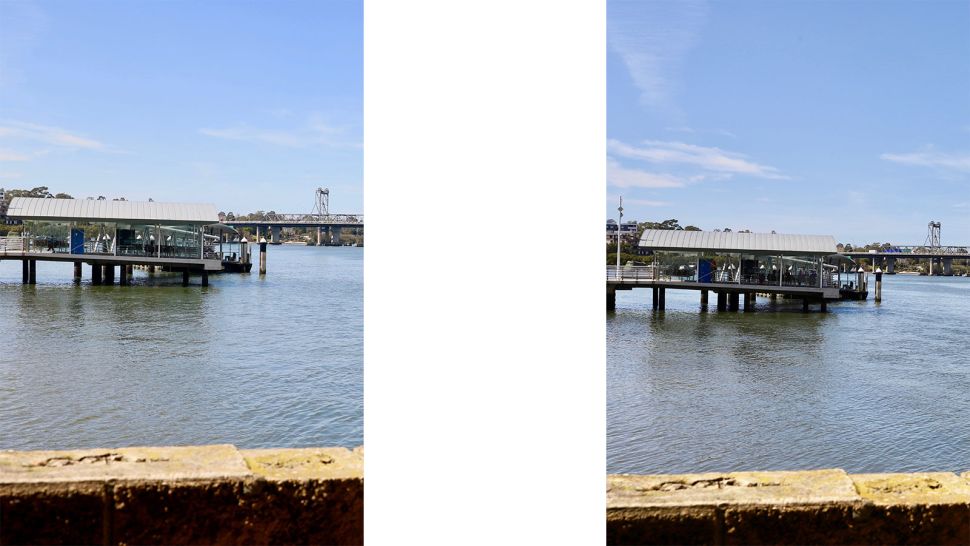
(Image credit: TechRadar)
We took a series of shots on a very sunny day only to find images appearing flat, with lack of details. When compared to the EOS 6D Mark II, we found the latter’s 26MP had a touch more detail and texture than the R6, as you can see in the 50% crop side-by-side JPEG comparison pictured above.
While the R6 handled the resolution of the bars through the glass wall of the ferry wharf really well, the 6D II had more detail on the roof of the wharf and the water surface. Even colors on the R6 image appear flatter in comparison to the DSLR.
That said, these are standard JPEGs – if you shoot HEIF files, the R6’s 10-bit dynamic range will come into play and you’ll be able to capture greater tonal range. Keep in mind that software support for HEIF is still limited, although it is the default file format for Apple’s Photos app, and you can convert all HEIFs into JPEGs in-camera.

(Image credit: TechRadar)
You’ll also find that the camera’s 20MP sensor has enough resolving power to allow for some cropping without excessive loss in quality, provided the image was shot at low ISO. As expected, you’ll find some details being lost at high ISOs, although it was only at ISO 20,000 that we began to see this problem. The R6 also handles noise quite well.
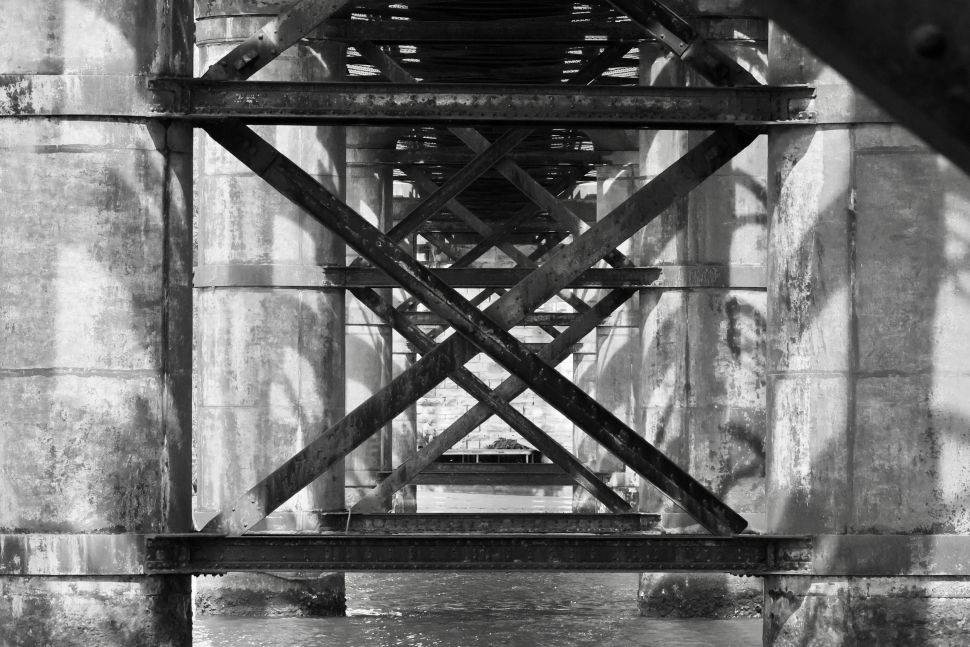
(Image credit: TechRadar)
Overall, it’s a very capable camera that produces excellent images, as long as you aren’t looking to print any of them in a size larger than A3.
Should I buy the Canon EOS R6?

(Image credit: TechRadar)
Buy it if…
Don’t buy if…
Source: Techradar

